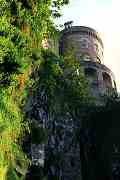|
The Beautiful, the Sublime and the Picturesque in the Eighteenth and early Nineteenth Century |
||||||||
|
|
"UNDER CONSTRUCTION"..DRAFT NOTES..
Concise Oxford Dictionary defines beautiful as 'delighting the eye', sublime as 'so distinguished by elevation or size or nobility or grandeur or other impressive quality as to inspire awe or wonder', and picturesque as 'fit to be the subject of a striking picture'.
1756 - Edmund Burke. "A Philosophical Inquiry into the Origin of Our Ideas of the Sublime and Beautiful".
In 1756 Edmund Burke published an essay entitled "A
Philosophical Inquiry into the Origin of Our Ideas of the Sublime and Beautiful".
Salvator Rosa (1615-73) His landscapes were greatly admired in the 18th and 19th centuries as embodiments of the picturesque and romantic landscape. Salvator Rosa was a prolific artist who is best known for the creation of a new type of wild and savage landscape. His craggy cliffs, jagged, moss-laden trees, and rough bravura handling create a dank and desolate air that contrasts sharply with the serenity of Claude Lorrain or the classical grandeur of Nicolas Poussin
http://www.kfki.hu/~arthp/art/r/rosa/river_la.jpg River Landscape with Apollo and the Cumean Sibyl. c. 1655 Oil on canvas, 174 x 259 cm. Wallace Collection, London. Has in the background a castle on a rocky clifftop overlooking a river.
A Friar Tempted by Demons. 1660-65. Oil on canvas 65 x
83 cm. Galleria Nazionale d'Arte Antica, Rome Adam would have seen reproduction of these paintings and other of this school at the library at Blair Adam.(footnote). Writng home from his grand tour in "
Alexander Pope His work is described by Alexander Pope's poem
Epistle to Lord Burlington, 1731 William Wordsworth Wordsworth immerses us in the natural sublime, taking us out of the role of spectator, making us sympathetic participants, in the passage where the Solitary stirs the feelings of the narrator by recalling the ecstatic joys of wandering amid the tumult of mountain cataracts:
How divine, The Solitary does not gaze, a spectator, upon nature as-object; for unlike Gilpin, he is not in search of the picturesque. Instead, he immerses himself in nature-as-process, trying with his roaming descent, with his passionate exclamations, to make himself part of the scene he encounters. Many of Burke's "qualities" present themselves to our notice: "the mists/Flying and rainy vapours" exemplify obscurity, the "deafening tumult" loudness, and the "mightiest energies" magnificence and power. But our point is not that the Solitary notices these qualities in a scene before him, but that he immerses himself in the tumult, joining his energy for a brief moment to mightiest energies, as the power, tumult, and magnificence of nature make their incursions upon his consciousness. So powerfully do they act upon him, so powerfully does he project himself toward and into them, that he enters the scene as participant, as one who experiences the sublime. The Solitary's apostrophe to the raging elements suggests chaotic merging of earth, sky, and water -- in short, the Turnerian vortex. But it is not the vortex which here chiefly represents the sublime experience. Using a narrative technique that is analogous to cinematic "panning," Wordsworth first places us high on the crags with the speaker, then brings us downward "from the region of the clouds," and finally plunges us into the tumult below *The visual organization, the Miltonic sonorous verse, and the apostrophe in the manner of Lear (who would also participate in the energies of the universe) all involve us in the sublime experience.
DOMENICHINO 1581 - 1641 The painting is one of Domenichino's most celebrated landscapes and was much admired by Constable.
|
|||||||
|
Jame Norrie. painter |
||||||||
interactive multimedia catalog
|
||||||||
|
Published
by Cadking Design Ltd, Edinburgh, Scotland - Copyright © Cadking
Design 1997-2001
|
||||||||
|
keywords: Concepts, Beautiful, Sublime, Picturesque, Eighteenth, Nineteenth, Century, Robert Adam, architecture, Georgian Architecture, C18 architecture, urban design, visionary architecture, architectural visionary, visionary,Cadking Design Ltd, visual catalog, visual catalogues, interactive multimedia catalogue, interactive multimedia catalog, multimedia catalogue, multimedia catalogue, architecture catalogue, architecture catalog
|
||||||||
